
PUMPA - SMART LEARNING
எங்கள் ஆசிரியர்களுடன் 1-ஆன்-1 ஆலோசனை நேரத்தைப் பெறுங்கள். டாப்பர் ஆவதற்கு நாங்கள் பயிற்சி அளிப்போம்
Book Free DemoAs we know, unlike animals and other organisms, plants cannot move. But they must adapt to their constantly changing environmental conditions. Animals adapt to these changes by relocating from one place to another when environmental conditions become unfavourable. However, plants cannot do this. Hence, they use other methods like tropism.
Plant tropism:
- These are mechanisms by which plants adapt to environmental changes.
- Unidirectional movement or growth of a whole of part of a plant towards the direction of stimuli is known as tropism.
- Some of the common stimuli that influence plant growth include light, gravity, water, and touch.
Types of tropism:
The phenomenon of tropism is classified into various types based on the nature of stimuli.
- Phototropism: The movement or growth of a plant towards the direction of light is known as phototropism.
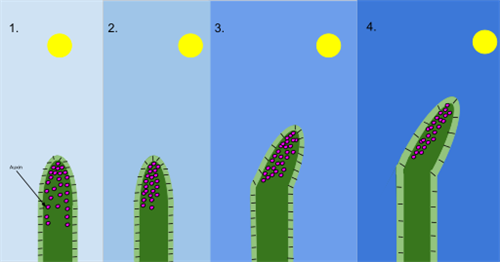
Shoot tip growing towards the direction of sun
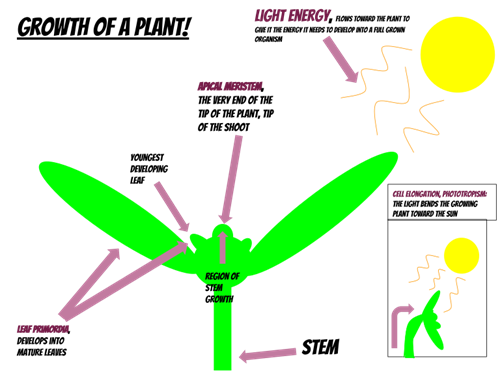
Growth of a plant related to the sunlight
Example:
The shoot of a plant:
The solar tracking of sunflower in accordance with the path of sun is due to phototropism.
(Refer to the video attached in the previous theory).
- Geotropism: The movement of a plant in response to gravity is known as geotropism.
Example: Root of a plant.
- Hydrotropism: The movement of a plant or a part of the plant towards water is known as hydrotropism.
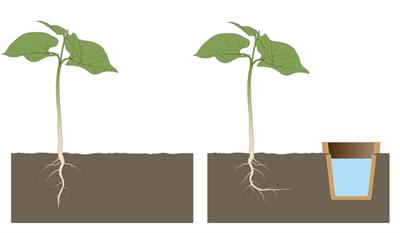
Plants showing hydrotropism
Example:
The root of a plant:
When a plant develops from a seed, the root of the growing plant tends to move towards the area of water. This is due to hydrotropism.
- Thigmotropism: The movement of a plant part due to touch is known as thigmotropism.
Climbing vines:
As we have studied in our lower classes, vines are examples of climbers that cannot grow without support. When a part of these climbers (tendrils) come in contact with the support, it starts to grow at a faster rate than the other parts, thus moving towards the direction of the stimulus.
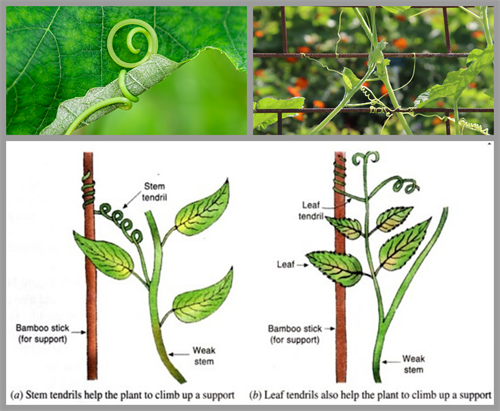
Tendrils showing Thigmotropism
- Chemotropism: The movement of a part of a plant in response to chemicals is known as chemotropism.
The growth of the pollen tube in response to the sugar content found in the stigma
.
Example:
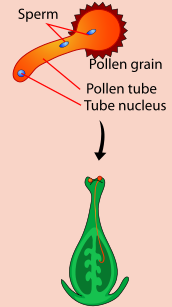
Pollen tube formation in the stigma
The process of tropism can be considered as positive or negative based on the direction of growth in accordance with the stimulus.
If the growth is towards the signal, tropism is considered positive. On the other hand, if the growth is away from the signal (stimulus), the tropism is considered negative.
If the growth is towards the signal, tropism is considered positive. On the other hand, if the growth is away from the signal (stimulus), the tropism is considered negative.
The shoot of a plant is positively phototropic as it 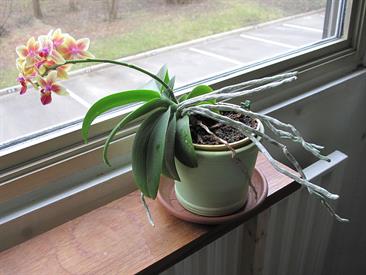
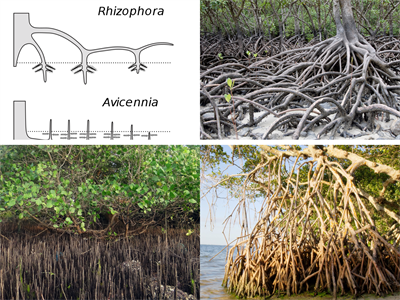
moves or grows towards the light. However, as roots grow away from the light, it is considered as negatively phototropic.

Positive and Negative Geotropism
In general, the shoot system of a plant is positively phototropic and negatively geotropic, whereas the root system is negatively phototropic and positively geotropic.
Some halophytes like Rhizophora have negatively geotropic roots. These roots turn 180° upright for respiration.

Negatively geotropic roots of Rhizophora & Avicenna - Mangrove forest
Reference:
https://upload.wikimedia.org/wikipedia/commons/thumb/1/14/Phototropism_Diagram.svg/512px-Phototropism_Diagram.svg.png
https://www.shutterstock.com/image-illustration/hydrotropism-s-plants-growth-response-which-1541322737
https://pixabay.com/photos/vine-tendril-embrace-green-noose-4102328/
https://pixabay.com/photos/cucurbit-climber-tendrils-hung-4460322/
http://lifeofplant.blogspot.com/2011/03/nastic-movements.html
https://commons.wikimedia.org/wiki/File:Pneumatophores.svg
https://pixabay.com/photos/australia-mangroves-plant-695200/
https://pixabay.com/photos/mangrove-species-breathing-roots-254393/
https://www.flickr.com/photos/34806414@N00/441496011/in/photolist-F1Moc-HeYJE-WCfNm-3KdUuS-42Zuvn-48f7Cy-4bAMjc-4bAMQT-4bEP2u-4ff1TC-4Aw6r5-4BPTMn-4FL2V9-547JQx-5FbkLt-5FbkUt-5LZ6ZC-6boRWi-6gm7Ue-6qoFmv-6xE5MK-6yt5Vd-6U1oxM-bJrwPg-93SEx3-e5NgH9-bJrwQV-9fqz6a-ckednC-ifPrGS-7Mt6oD-eedEx3-ee3DEu-eedDwU-ee4bN5-edXw7M-ee4e1f-edXzb2-ee4iDN-ee4hGy-7X3TLU-ee48sE-edXhLz-edX6X8-edX4EP-ee3Ph3-9KVS6W-ee3Ny7-edXoaz-edWYUr-9nmvp3
https://pixabay.com/photos/australia-mangroves-plant-695200/
https://pixabay.com/photos/mangrove-species-breathing-roots-254393/
https://www.flickr.com/photos/34806414@N00/441496011/in/photolist-F1Moc-HeYJE-WCfNm-3KdUuS-42Zuvn-48f7Cy-4bAMjc-4bAMQT-4bEP2u-4ff1TC-4Aw6r5-4BPTMn-4FL2V9-547JQx-5FbkLt-5FbkUt-5LZ6ZC-6boRWi-6gm7Ue-6qoFmv-6xE5MK-6yt5Vd-6U1oxM-bJrwPg-93SEx3-e5NgH9-bJrwQV-9fqz6a-ckednC-ifPrGS-7Mt6oD-eedEx3-ee3DEu-eedDwU-ee4bN5-edXw7M-ee4e1f-edXzb2-ee4iDN-ee4hGy-7X3TLU-ee48sE-edXhLz-edX6X8-edX4EP-ee3Ph3-9KVS6W-ee3Ny7-edXoaz-edWYUr-9nmvp3